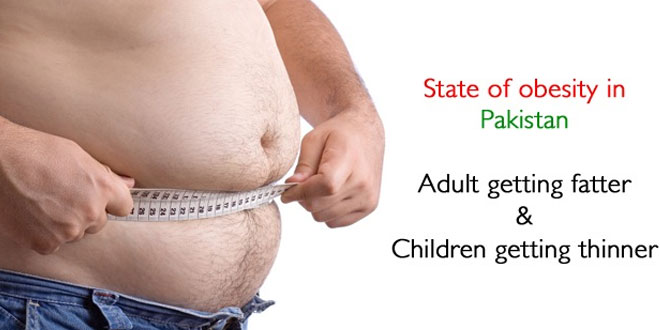
Paki Adults getting Fatter – Children getting thinner
One third of adults in Pakistan are overweight or obese, and the gender gap in excess weight is widening, with more women gaining weight than men, according to a new, first-of-its-kind analysis of trend data from 188 countries, published in The Lancet.
“These global findings underscore the double burden of malnutrition in Pakistan with high rates of under-nutrition among children, and adolescents/young women and rising rates of obesity among adults”, said Dr Zulfiqar Bhutta, Founding Director of the Centre for Excellence in Women and Child Health at Aga Khan University. “Some of these issues may be related to rapid health transitions with changes in lifestyle, dietary patterns and limited physical activity”.
The study conducted by an international consortium of researchers led by the Institute for Health Metrics and Evaluation (IHME) at the University of Washington shows that rates of adult overweight and obesity have grown globally from 30 per cent in 1980 to 37 per cent in 2013.
The results show that South Asia has seen a steady increase in overweight and obesity since 1980, with the rate of overweight or obese adults rising from 16 per cent to 21 per cent in 2013. However, 21 per cent is the second lowest adult prevalence among all regions globally. South Asia also has the lowest child overweight/obesity prevalence among all regions (six per cent) and the lowest child obesity prevalence (three per cent).
Pakistan has seen rates increase from 26% to 33% over the same period, and by gender the differences are striking. In 1980, 24 per cent of men and 29 per cent of women were overweight or obese, a five percentage point difference, but, in 2013, the rates were 28 per cent for men and 38 per cent for women, the largest gap in the region. India, by comparison, had one per cent difference between men and women.
In Pakistan, children and adolescents of both sexes were found to have lower overweight or obesity rates than the global average of 14 per cent for both boys and girls. Pakistani children had overweight and obesity rates of six per cent for boys and 10 per cent for girls in 2013. Boys in Pakistan saw a two per cent reduction in these rates over 33 years, while girls saw one per cent reduction.
Within the region, Pakistan has the highest obesity rate for adults (14 per cent), and Bhutan has the highest obesity rate for children (six per cent). South Asia also has the smallest gender gap in adult obesity among all regions (4.8 per cent male, 5.2 per cent female).
Source: Medical News Pakistan

